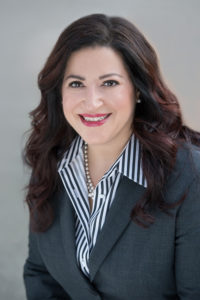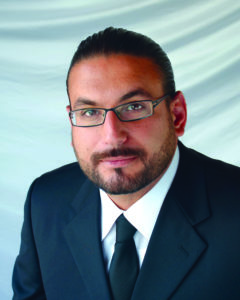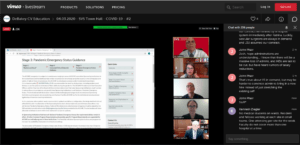
We certainly live in interesting times—times in which social distancing has literally become the new normal. COVID-19 came to the United States quietly and then hit like a brick, creating a national emergency. It is almost difficult to remember what it was like to live in the times that came before: Politely declined family events or get-togethers with friends are but distant and vague memories. As a busy vascular surgeon, one is frequently involved in so many roles that barely any time is left for self-reflection or family and friends. Then there is the time we live in now—a time of crisis that has forced some of the world’s population to slow down while others have become busier than ever.

Social distancing refers primarily to physical distancing. The goal of public health during an epidemic is to contain any contagion before it progresses rapidly into what we are unfortunately experiencing currently: a pandemic. Even worse, this pandemic is unprecedented in our lifetimes, continuing to grow exponentially. The public health measures put forth are achieved by aggressively promoting social distancing and density reduction in an effort not just to mitigate but suppress the outbreak.
And so, in this surreal upside-down now in which we exist, we have hit upon a silver lining in amongst our new norms in the form of blossoming friendships among our professional colleagues. These formal and informal peer-to-peer connections have created a forum in which to share our institutional experiences, celebrate little wins, and confront our anxieties and fears. It has been remarkable to realize just how interconnected we have always been—and also how we are not alone. We have learned that relying on each other in real time is not only soothing psychologically, but translatable to real clinical benefits with real-time learning so that we may continue to serve our patients and communities the best we can.
We have tackled challenges of all shapes and sizes: From learning together how to avoid bringing the virus back to our families, and designating changing spaces in our homes, to sharing large-scale, hospital-applicable protocols such as the Vascular Surgery Readiness Condition (see VASC-CON in Figure 1). We have shared our evolving hospital COVID-19-specific practices and kept up in real time with the changes sweeping through our vascular surgery workforce. We have realized that it is safe to show our humanity as we detail our frustrations. We have seen the dripping compassion of our brothers and sisters in vascular surgery on a massive, global scale.

Perhaps in the times that came before, many of us were not in peer-to-peer support environments, perhaps for many of the same reasons that preoccupied our past lives. In these times of crisis, maybe you want to vent, perhaps you are scared, maybe you are worried—maybe you know of things that could help others. We should be here for each other—indeed, we are here for each other! Peer-to-peer support is essential. More than ever before, we find ourselves in a position where we need to connect. We realize that even though we are physically isolated, we don’t have to be emotionally or socially isolated.
These are difficult times; we don’t have to go through this alone. We find ourselves willing to learn how to use new communication platforms. These have quickly proliferated to fill the void created by social distancing. An example is the WhatsApp Vascular Surgeon COVID-19 group created by Max Wohlauer, MD, of the University of Colorado, in the early days of the pandemic reaching the United States. Within five days of its inception, 256 vascular surgeons from 24 countries were actively sharing stories, worries, ideas, information, guidelines, protocols and techniques.

Multiple social media platforms are being used by vascular surgeons, including SVSConnect, Twitter, LinkedIn and Facebook. All of these platforms have provided us with an opportunity to share cases, meet others globally and disseminate research results. Vascular Twitter has been a great platform for the sharing of news, articles and meeting other vascular surgeons around the world. A great advantage of this platform is that it tends not to be too time-consuming yet incredibly helpful in connecting by topic. Facebook has a long-standing history of use and continues to serve as a platform where we can lean on each other in public or private. LinkedIn provides an online professional platform. Newer additions in the time of our new normal include conferencing communication tools such as Zoom. We have used it in the past for research meetings—and now for large and small social gatherings (see Figure 2).
In addition to SVSConnect, the Society for Vascular Surgery (SVS) leadership of president Kim Hodgson, MD, and executive director Kenneth M. Slaw, PhD, along with the SVS Executive Committee, rapidly rolled out a program of virtual SVS Town Halls as the COVID-19 pandemic took hold in the U.S.

The first session, convened on March 28, was entitled “The impact of COVID-19 on clinical practice” and led by Hodgson, Alan Lumsden, MD, Benjamin W. Starnes, MD, president-elect Ronald L. Dalman, MD, Daniel McDevitt, MD, and Thomas Forbes, MD. The second session followed on April 3 under the theme “The impact of COVID-19 on education, training and wellness.” The second in the series included Hodgson and Lumsden as co-moderators once more, along with Rabih Chaer, MD, Dawn M. Coleman, MD, Amy Reed, MD, and Gilbert R. Upchurch, MD (see Figure 3). Both sessions proved immensely successful, attracting more than 4,500 viewers across both the livestreams of the events and additional views on Facebook, YouTube and Twitter.
In the times of now, this new normal is something to which we are all continuing to adapt. As vascular surgeons, we are busy. We have always been busy. We will continue to be busy. But this crisis has given us moments for pause amid our usually bustling schedules, allowing time for reprioritization of all that is important. As we tap into our stores of resiliency and experience, and new emotions of grief and anger, we will be traveling through these times together, looking forward to the future. It is our hope that in the times that come after COVID-19, we will continue to maintain our peer-to-peer support networks and remain connected more than ever.
Sherene Shalhub, MD, is associate professor of surgery in the division of vascular surgery, the department of surgery, at the University of Washington School of Medicine, Seattle. Nicolas Mouawad, MD, is the chief of vascular and endovascular surgery at McLaren Bay Heart & Vascular in Bay City, Michigan.












